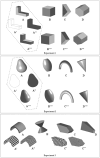Contrasting the edge- and surface-based theories of object recognition: behavioral evidence from macaques (Macaca mulatta)
- PMID: 20141325
- PMCID: PMC4199308
- DOI: 10.1037/a0015629
Contrasting the edge- and surface-based theories of object recognition: behavioral evidence from macaques (Macaca mulatta)
Abstract
This study assessed the contribution of edge and surface cues on object representation in macaques (Macaca mulatta). In Experiments 1 and 2, 5 macaques were trained to discriminate 4 simple volumetric objects (geons) and were subsequently tested for their ability to recognize line drawings, silhouettes, and light changes of these geons. Performance was above chance in all test conditions and was similarly high for the line drawings and silhouettes of geons, suggesting the use of the outline shape to recognize the original objects. In addition, transfer for the geons seen under new lighting was greater than for the other stimuli, stressing the importance of the shading information. Experiment 3, using geons filled with new textures, showed that a radical change in the surface cues does not prevent object recognition. It is concluded that these findings support a surface-based theory of object recognition in macaques, although it does not exclude the contribution of edge cues, especially when surface details are not available.
Figures






References
-
- Biederman I. Recognition-by-components: A theory of human image understanding. Psychological Review. 1987;94:115–147. - PubMed
-
- Biederman I, Ju G. Surface- versus edge-based determinants of visual recognition. Cognitive Psychology. 1988;20:38–64. - PubMed
-
- Davenport RK, Rogers CM, Russel IS. Cross-modal perception in apes: Altered visual cues and delay. Neuropsychologia. 1975;13:229–235. - PubMed
-
- Dean P. Effects of inferotemporal lesions on the behavior of monkeys. Psychological Bulletin. 1976;83:41–71. - PubMed

